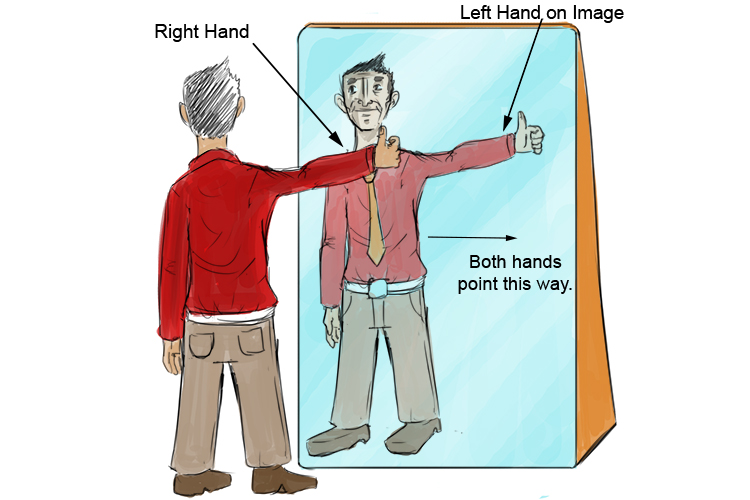Visual Perception: How Others Actually See You in Real Life
The mirror image paradox: how we see ourselves vs. How others see us
Have you always look at a photo of yourself and think you look strange or different from what you see in the mirror? This common experience stem from a fascinating aspect of visual perception that many people don’t realize: the image you see in the mirror is really invert compare to how others see you in real life.
When you look in a mirror, you’re seen a horizontally flip version of yourself. Your right sideappearsr as your left, and frailty versa. This mirror image become what you consider yo” ” norma” appearance because it’s what you see every day. Yet, everyone else see you without this horizontal flip.
The science behind mirror inversion
Mirrors don’t really invert image top to bottom — they reflect light flat backwards. What we perceive as inversion happen because we turn to face the mirror. When you raise your right hand while face a mirror, your reflection appears to raise its left hand. This isn’t because the mirror flip the image but becauseyoure ffacedopposite directions.
This phenomenon creates an interesting psychological effect. The version of yourself you’rewell-nighh familiar with — the one you see in mirrors — is ne’er the version others see. Your brain become accustomed to this flip image as your identity.
The familiarity effect
Research in cognitive psychology show we tend to prefer familiar images of ourselves. In a notable study, participants were show photos of their faces in both orientations — the mirror image they were used to see and thenon-reversedd image others see. Most people prefer their mirror image, while their friends prefer thenon-reversedd image they wereaccustomedm to see.
This preference for familiarity explain why many people feel uncomfortable with photos of themselves. The photo show how others really see you, which look” wrong ” o you because it’s the opposite of what yoyourse usedsee in mirrors.
Do people see you upside downward or inverted?
A common misconception is that others might see you vertically invert or top downwards. This isn’t the case. The only difference between how you see yourself in a mirror and how others see you is the horizontal flip. Your top remain top and bottom remain bottom for everyone — there be no vertical inversion in human visual perception.
The human visual system process images systematically across individuals. Light enter through the lens of the eye and project a ttop-downimage onto the retina. The brain so flip this image right side up during processing. This neural mechanism work the same way in all people with typical visual systems.
The retinal inversion phenomenon
While images do project top down on our retinas, our brains mechanically correct this inversion during visual processing. This happens thus seamlessly that we’re ne’er aware of it. Everyone’s brain perform this same correction, so there be no difference in vertical orientation between how different people perceive the world.
Interestingly, experiments with special inversion goggles have shown that the brain can adapt yet if visual input is unnaturally invert. When subjects wear these goggles for extended periods, their brains finally adjust and begin to perceive the invert world as normal — demonstrate the remarkable adaptability of our visual processing systems.
The reality of how others see you
The truth is that others see you horizontally flip compare to how you see yourself in mirrors. Your left side appear as their left (not your right, as in a mirror ) and your right side appear as their right. This memeansny asymmetrical features of your face appear reverse to others compare to what yyouruseused see.

Source: wikihow.com
Most human faces have subtle asymmetries — one eye might be slender larger, one side of the smile high, or the nose might lean slslendero one side. These asymmetries appear reverse in your mirror image compare to how others see them in real life.
Facial asymmetry and perception
These facial asymmetries can impact how you perceive yourself versus how others perceive you. For example, if you have a feature you consider prominent on the right side of your faceyourre used to see it on the left side in your mirror image. Others, nonetheless, see it on your actual right side.
Research suggest that we tend to judge ourselves more gratingly than others do. We notice our own asymmetries and perceive flaws often more than others do. This self-critical tendency, combine with the unfamiliarity of see our non-mirrored image, can make us uncomfortable with how we look in photographs.
The true mirror experiment
Some researchers have create” true mirrors” by place two regular mirrors at right angles to each other. This setup produce a nnon-reversedimage, show you how others really see you. People oftentimes report feel strange or uncomfortable when firstly look into a true mirror because the image contradict their lifelong familiarity with their reversed reflection.
This experiment highlight how deep ingrain our mirror image become to our sense of self. Many people describe the experience of see their true, non-reversed face as look at a stranger or a sibling quite than themselves.
Digital self perception
Modern smartphone cameras oftentimes have a” mirror selfie ” ption that horizontally flip the image to match what we see in mirrors. This feature exexistsxactly because people tend to prefer their familiar mirror image over their actual appearance. Some video conferencing platforms likewise mirror your self view while show others your nnon-mirroredimage.
These technological accommodations highlight our psychological attachment to our mirror image, yet though it’s not how others perceive us in reality.

Source: mammothmemory.net
Beyond physical appearance: psychological perception
How others see you extend far beyond upright the horizontal orientation of your face. People perceive you through multiple filters, include:
The spotlight effect
Psychological research has identified what’s call t” ” spotlight effect”—our tendency to overestimate how much others notice our appearance and behavior. In reality, people are broadly less focused on your appearance than you imagine. They’re frequentlypreoccupiedy with their own concerns aself-imageage.
This mean that small flaws or asymmetries you might obsess over probable go unnoticed by most people you interact with. The spotlight effect explains why we frequently feelself-consciouss about minor issues that others seldom perceive.
Personality and behavior
How others perceive you is importantly influenced by your personality, behavior, and expressions. Dynamic aspects like your smile, voice, gestures, and conversational style contribute more to others’ overall impression of you than the static aspects of your appearance.
Research in social psychology show that personality traits frequently overshadow physical features in form last impressions. People are more likely to remember how you make them feel than specific details about your physical appearance.
The role of context in perception
Context importantly influences how others see you. The same person canbe perceivede otherwise in various settings:
Professional vs. Social settings
People may perceive you otherwise in professional environments compare to social gatherings. Clothing, demeanor, and communication style oftentimes shift between contexts, alter others’ perceptions consequently.
Studies show that people tend to notice different aspects of your appearance and behavior depend on the setting. In professional contexts, competence cues might be more salient, while in social settings, warmth and approachability might be more prominent.
Familiarity and relationship dynamics
How substantially someone know you dramatically affect their perception. Close friends and family see you otherwise than acquaintances or strangers do. People who know you intimately are more likely to look past surface level appearance and see you in terms of your personality, history, and relationship with them.
This familiarity effect explain why close friends oftentimes have a more positive and complex view of your appearance than you might have of yourself.
Cultural factors in visual perception
Cultural background influence how people perceive and interpret facial features and expressions:
Cultural differences in attention patterns
Research use eye track technology has shown that people from different cultures focus on different parts of the face when look at others. For example, studies suggest that western observers tend to focus more on the eyes and mouth, while eastAsiann observers distribute their attention more holistically across the entire face.
These cultural differences in visual attention can subtly affect how people from different backgrounds perceive the same face.
Beauty standards and perception
Cultural beauty standards besides influence how others perceive your appearance. Features consider attractive in one culture might be view neutrally or yet negatively in another. These cultural lenses affect not precisely how others see you but likewise how you see yourself.
The good news is that beauty standards are progressively diverse and fluid in our interconnected world, make rigid judgments less common than in previous generations.
The reality check: how to see yourself as others do
If you’re curious about how others sincerely see you, there be several approaches you can take:
Video recordings
Video recordings provide a more accurate representation of how others see you than mirrors do. They capture not upright your non-reversed appearance but likewise your movements, expressions, and mannerisms that contribute importantly to others’ perceptions.
Watch recordings of yourself in conversation or give presentations can provide insights into how you appear to others in dynamic social situations.
Photography
Regular photographs show your non-reversed image. While initially, these might look strange to you, they accurately represent how others see your static appearance. Over time, you can become more comfortable with this actual image.
It’s worth note that camera lenses can distort appearance base on focal length. Selfies take at close range frequently distort facial features, make them poor representations of how others see you from normal conversational distances.
Feedback from trusted others
Sometimes the well-nigh valuable insights come from plainly ask trust friends or family members how they perceive you. Their perspectives can help balance your self perception and highlight positive aspects you might overlook.
Remember that their perception is influence by their relationship with you and often include more than but your physical appearance.
Embrace the difference between self perception and reality
Understand the difference between how you see yourself and how others see you can be liberating. Here’s why:
Reduced self consciousness
Recognize that others don’t see the flaws you focus on — or see them otherwise — can reduce unnecessary self consciousness. The asymmetries you notice in your face might be wholly overlooked by others or yet consider distinctive and attractive.
Studies systematically show that we’re our own harshest critics. Most people are far less judgmental of others’ appearances than they’re of their own.
Authentic self presentation
Understand that your mirror image isn’t how others see you allow you to make more inform choices about self presentation. For instance, if you’re will practice facial expressions or hairstyles, you might, will want to will use video ornon-reversedd images for a more accurate representation of what others will see.
This knowledge can help you align your self presentation with how you want to be perceived by others.
Conclusion: the multifaceted nature of perception
The question of how others see you have a complex answer that go beyond simple visual mechanics. Yes, others see a horizontally flip version of what you see in the mirror. No, they don’t see you invert or top down. But perception encompass practically more than precisely the orientation of your image.
Others see you through the lens of their own experiences, cultural background, and relationship with you. They notice your expressions, behaviors, and personality angstrom often as — if not more than — the static features of your face.
Perchance virtually significantly, others typically see you more holistically and less critically than you see yourself. The asymmetries and perceive flaws that might bother you when look in a mirror oftentimes go unnoticed by others or are seen as unique characteristics that make you distinctively you.
Understand these aspects of perception can help you develop a healthier relationship with your image and reduce unnecessary self consciousness. Afterward wholly, the version of yourself that exist in others’ minds is oftentimes more favorable than the one that exist in your own.



